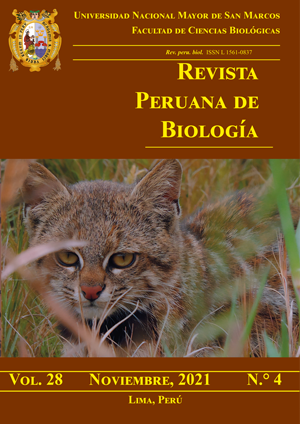Description of the nest of Phyllotis andium (Cricetidae: Phyllotini), in a inter Andean dry scrub in Ecuador.
DOI:
https://doi.org/10.15381/rpb.v28i4.20158Keywords:
Azuay, cricetids, temperate zoogeographic region, Pennisetum clandestinum, grassAbstract
In this work, we describe the structure of the nest of Phyllotis andium Thomas, 1912 in an inter-Andean dry scrub in the south of the Azuay province in Ecuador, and the use of an introduced grass in their manufacture. Observations on sociability and abundance of this species are also presented. These data provide new information on the intraspecific relationships of these rodents and their natural history.
Downloads
References
Albuja L, Almendáriz A, Barriga R, et al. 2012. Fauna de vertebrados del Ecuador Escuela Politécnica Nacional. 490pp.
Arana M, Ramírez O, Santa María S, et al. 2002. Population density and reproduction of two Peruvian leaf-eared mice (Phyllotis spp.). Revista Chilena de Historia Natural 75:751–756.
Aguirre Z, Medina-Torres B, Josse C. 2013. Arbustal semideciduo del sur de los Valles In: Ministerio del Ambiente del Ecuador, eds, Sistema de Clasificación de los Ecosistemas del Ecuador Continental. Ministerio del Ambiente del Ecuador, Quito. Pp. 157–158.
Brito J, Teska WR, Ojala-Barbour R. 2012. Descripción del nido de dos especies de Thomasomys (Cricetidae) en un bosque alto-andino en Ecuador. Therya 3:263–268.
Brito J, Orellana H, Tenecota G. 2014. Descripción del nido de Hylaeamys yunganus (Rodentia: Cricetidae) de los Andes del sureste de Ecuador. ACI Avances en Ciencias e Ingenierías 6:b10–b12.
Cudworth NL, Koprowski JL. 2010. Microtus californicus (Rodentia: Cricetidae). Mammalian Species, ser. 42, 868:230–243.
Ebensperger LA, Taraborelli P, Giannoni SM, et al. 2006. Nest and space use in a Highland population of the southern mountain Cavy (Microcavia australis). Journal of Mammalogy 87:834–840.
Hamilton WJ. 1982. Baboon sleeping site preferences and relationships to primate grouping patterns. American Journal of Primatology, ser. 3, 1–4:41–53.
Kolbe JJ, Janzen FJ. 2002. Impact of nest-site selection on nest success and nest temperature in natural and disturbed habitats. Ecology 83:269–281.
Mears PE. 1970."Kikuyu (Pennisetum clandestinum) as a pasture grass." Tropical Grasslands 4:139–152.
Muñoz-Pedreros A. 2000. Orden Rodentia. In: A. Muñoz-Pedreros and J. Yañez, eds. Mamíferos de Chile. CEA Ediciones, Valdivia. Pp. 73–126.
Nivelo-Villavicencio C, Timbe B, Astudillo PX. 2021.Observaciones de forrajeo en recursos florales por Phyllotis haggardi (Rodentia: Cricetidae) en un ecosistema de páramo al sur del Ecuador. Neotropical Biodiversity 7:376–378.
Pardiñas U, Ruelas D, Brito J, et al. 2017. Andean Leaf-eared Mouse Phyllotis andium. In: D.E. Wilson, T.E. Lacher Jr, and R.A. Mittermeier, eds. Handbook of the Mammals of the World-Volume 7: Rodents II. Lynx Editions, Barcelona. Pp. 245.
Rengifo EM, Aquino R. 2012. Descripción del nido de Scolomys melanops (Rodentia, Cricetidae) y su relación con Lepidocaryum tenue (Arecales, Arecaceae). Revista Peruana de Biología 19:213–216.
Rengifo EM, Pacheco V. 2015. Taxonomic revision of the Andean leaf-eared mouse, Phyllotis andium Thomas 1912 (Rodentia: Cricetidae), with the description of a new species. Zootaxa 4018:349–380.
Steppan SJ. Ramírez O. 2015. Genus Phyllotis. In: J.L. Patton, U.F.J. Pardiñas and G. D’Elia, eds. Mammals of South America: Rodents (Vol. 2). University of Chicago Press, Chicago. Pp. 535–555.
Tirira DG. 2017. Mamíferos del Ecuador. Guía de campo. Ediciones Murciélago Blanco. Publicación Especial de los Mamíferos del Ecuador 10, Quito. 576pp.
Udrizar Sauthier, WO, Abba AM, Udrizar Sauthier DE. 2010. Nests of Oligoryzomys sp. and Holochilus brasiliensis (Rodentia, Cricetidae) in eastern Entre Ríos province, Argentina. Mastozoología Neotropical 17:207–211. https://www.sarem.org.ar/mastozoologia-neotropical-vol17-no1/
Yunes RMF, Cutrera RA, Castro-Vázquez A. 1991. Nesting and digging behavior in three species of Calomys (Rodentia; Cricetidae). Physiology & behavior 49:489–492.
Villareal AJ. 2019. Caracterización del uso de hábitat de tres especies de roedores en páramos de la Reserva Ecológica Antisana. Tesis, Licenciatura en Ciencias Biológicas, Facultad de Ciencias Exactas y Naturales, Pontificia Universidad Católica del Ecuador. http://repositorio.puce.edu.ec/handle/22000/16940
Zeballos H, Vivar E. 2016. Phyllotis andium (errata version published in 2017). The IUCN Red List of Threatened Species 2016: e.T17221A115140147. [accessed 2020 Nov 22].
Downloads
Published
Issue
Section
License
Copyright (c) 2021 Carlos Nivelo-Villavicencio, Amanda B. Quezada, José Vieira

This work is licensed under a Creative Commons Attribution 4.0 International License.
AUTHORS RETAIN THEIR RIGHTS:
a. Authors retain their trade mark rights and patent, and also on any process or procedure described in the article.
b. Authors retain their right to share, copy, distribute, perform and publicly communicate their article (eg, to place their article in an institutional repository or publish it in a book), with an acknowledgment of its initial publication in the Revista Peruana de Biologia.
c. Authors retain theirs right to make a subsequent publication of their work, to use the article or any part thereof (eg a compilation of his papers, lecture notes, thesis, or a book), always indicating its initial publication in the Revista Peruana de Biologia (the originator of the work, journal, volume, number and date).






